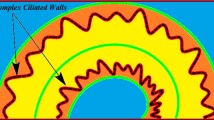Abstract
The propulsion mechanics of cilia-induced flow is studied through a mathematical model. The problem of two-dimensional motion of a power law fluid inside a channel with ciliated walls is considered. The characteristics of ciliary systems are determined by the dominance of viscous effects over inertial effects using the long-wavelength approximation. Solutions for the longitudinal, transverse, and resultant velocities are obtained. The pressure gradient and volume flow rate for different values of the power law index are also calculated. The flow properties for the power law fluid are determined as a function of the cilia and metachronal wave velocity. The viscous and power law fluid are compared and discussed graphically.










Similar content being viewed by others
References
Sleigh MA. Cilia Endeavor. 1971;30(109):7–11.
Jahn B. Movement and locomotion of microorganism. Annu Rev Microbiol. 1965;19:21–58.
Blake JR. A spherical envelope approach to ciliary propulsion. J Fluid Mech. 1971;46:199–208.
Miller CE. An investigation of the movement of Newtonian liquids initiated and sustained by the oscillation of mechanical cilia. In: Proceedings of 5th congress on applied mechanics. 1966. p. 715–20.
Miller CE. Stream lines, steak lines and particle pathlines associate with a mechanically-induced flow holomorphic with the mammalian mucociliary system. Biorheology. 1969;6:127–35.
Blake JR. Mucus flows. Math Biosci. 1973;17:301–13.
Blake JR. On the movement of mucus in the lungs. J. Biomech. 1975;8:179–90.
Sleigh MA. Adaptations ofciliary systems for the propulsion of water and mucus. Comput Biochem Physiol. 1989;2:359–64.
Fulford GR, Blake JR. Muco-ciliary transport in the lung. Theor Biol. 1986;121:381–402.
Agarwal M. Mucus transport in the lung. Math Comput Model. 1988;2:797–800.
Gueron S, Liron N. Ciliary motion modeling, and dynamic multicilia interactions. Biophys J.1992;63:1045–58.
Rao PM. Mathematical model for the propulsion of a ciliated micro-organism with differential spin. Math Comput Model. 1989;13I:127–36.
Greep RD. Histology. New York: Blakiston Division, McGraw-Hill;1966.
Lardner TJ, Shack WJ, Waibel E. A survey of reproductive biology. Report to The Pathfinder Fund, Dept. of Mech. Eng., M.I.T;1970.
Sturgis SH. The effect of ciliary current on sperm progress in Exeised Haman fallopian tubes. Trans Am Soc Stud Steril. 1947;3:31–9.
Blandau RJ. Gamete transport-comparative aspects. In: Hafez ES, Blandau RJ editors. Chicago: Univ. of Chicago Press;1969. p. 129–62.
Blake JR. Flow in tubules due to ciliary activity. Bull Math Biol. 1973;35:513–23.
Lucus AM. Ciliated epithelium. Special Cytol. 1932;1:409–73.
Lardner TJ, Shack WJ. Cilia transport. Bull Math Biophys. 1972;34:325–35.
Blake JR. Infinite models for ciliary propulsion. J Fluid Mech. 1971;49:209–22.
Sleigh MA. Patterns of ciliary beating. In aspect of cell motility, 131. Soc.Expl. Biol. Symp. XXII. New York: Academic; 1968.
Agarwal HL, Anawaruddin. Cilia transport of bio-fluid with variable viscosity. Indian J Pure Appl Math. 1984;15(10):1128–39.
Author information
Authors and Affiliations
Corresponding author
About this article
Cite this article
Siddiqui, A.M., Haroon, T., Rani, M. et al. An analysis of the flow of a power law fluid due to ciliary motion in an infinite channel. J Biorheol 24, 56–69 (2010). https://doi.org/10.1007/s12573-011-0026-3
Received:
Accepted:
Published:
Issue Date:
DOI: https://doi.org/10.1007/s12573-011-0026-3



